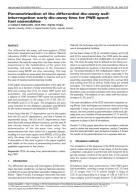Details
- Identification
- ISSN: 1977-5296, DOI: 10.3011/ESARDA.IJNSNP.2019.2
- Publication date
- 1 June 2019
- Author
- Joint Research Centre
Description
Volume: 58, June 2019, pages 13-21,
Authors: Li Caldeira Balkeståhl, Zsolt Elter, Sophie Grape
Uppsala University
Abstract:The differential die-away self-interrogation (DDSI) instrument developed and built in Los Alamos National Laboratory (LANL) is being considered for verification before final disposal. One of the signals from this instrument, the early die-away time, has been shown to be proportional to the multiplication of the spent fuel assembly. Full-scale simulations of the instrument response using MCNP are time consuming. This may become a problem in cases when the instrument response to a large number of fuel assemblies is required, such as in the case of training machine learning models.
In this paper, we propose a parametrization of the early dieaway time as a function of initial enrichment (IE), burn-up (BU) and cooling time (CT), for intact PWR spent fuel assemblies. The parametrization is calculated from a dataset of 1040 simulated PWR spent fuel assemblies with fuel parameters in the range of IE=2-5%, BU=15- 60 GWd/tU and CT=5-70 years. The simulations are done using Serpent2 for the depletion calculation and MCNP6 for the neutron transport and detection in the DDSI.
It was found that the CT dependence can be decoupled from the BU and IE dependence, and that it follows an exponential decay. The BU and IE dependences have been fitted with several different functions, and the best fit was chosen based on the chi-square value. The determinat ion of the die-away time using the parametrization has been tested on a separate dataset, resulting in a root mean square error (RMSE) of 0.6 μs (the early die-away time ranges from 28 μs to 84 μs). A description of this work is given in the paper together with details on the choice of parametrizing function, and qualitative arguments for that choice.
Keywords: DDSI; die-away time; parametrization; modelling; PWR
Reference guideline:
Caldeira Balkeståhl, L., Elter, Z., & Grape, S. (2019). Parametrization of the differential die-away self-interrogation early die-away time for PWR spent fuel assemblies. ESARDA Bulletin - The International Journal of Nuclear Safeguards and Non-proliferation, 58, 13-21. https://doi.org/10.3011/ESARDA.IJNSNP.2019.2

